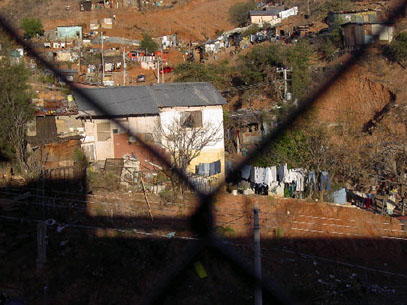|
BorderLinks |
|
| Return to Kathy Lorenz's Home Page |
 |
|
Above: Colonia Chefs - Manuela, Ignacia and Mari Return to Migration & Culture Home Page
BorderLinks Trip to Mexico The BorderLinks trip to Nogales, Sonora, Mexico was nothing short of awe-inspiring. Throughout the entire trip, I experienced the whole gamut of emotions, ranging from shock, disappointment and tears to amazement, hope and laughter! Whatever pre-conceived ideas or mental pictures I had, of the Mexican family life, were forever lost upon experiencing the reality of it all. I never dreamed a two hour lunch would have such a profound effect on me, but it did! Having lunch with a Mexican family in a colonia was, in my opinion, the
most fascinating and educational aspect of my trip. Upon entering the
colonia-a squatters’ settlement district, I was immediately taken aback by
the visuals. I had read about “colonias having no potable water, no
electricity, no sidewalks and no infrastructure” and how its due, in large
part, to the “Maquiladora Industry…these foreign-owned (U.S.) assembly
plants that perpetuate this poverty, with their exploitation of labor
($9/day wage)…these corporations do not contribute to the community
well-being, in the form of paying local taxes, so they are, in effect,
taking from the community…they are stripping, devouring and destroying the
community-all under the guise of bringing jobs!” (Torres, 1997) But,
reading about a neighborhood with no services cannot be compared with the
actual firsthand experience of seeing and being within one. I really was
not prepared for what I saw…structures (house-like) that appeared to
provide the most minimal amount of protection and shelter. Hundreds of
these tiny structures, resembling lean-tos, were stacked and crammed onto
this hill. I tried to take it all in, but it was impossible. Driving
through the colonia, I observed many things that were unfamiliar: house
structures that appeared to be situated right on top of or right next to a
garbage dump, appliances (if the family had any) were kept outside,
cardboard shelter devices and blankets or sheets being used as doors,
houses that looked to be structurally unsafe (if they were to be hit by a
storm they surely would collapse), water containers that sat on top of
these structures (a water truck would try and come by to fill up these
small containers each day-never enough to make it through the day though),
outhouses galore-due to the obvious lack of indoor plumbing! While it is
true that I saw many things foreign, unfamiliar and shocking, I also saw
just as many things that were ordinary, familiar and amazing: dogs as
pets, children outside laughing and playing, neighbors visiting each
other, music could be heard in the distance, boys playing soccer in an
open field, clothes hanging outside to dry-as a side note, their whites
were the whitest I have ever seen, which is truly amazing since there are
no paved roads in the colonia! I was shocked to see their living
conditions and yet, amazed at their awesome survival skills!
Having lunch with a Mexican family, in the colonia, was an experience I will never forget. The family lived in a one room house, with a curtain partition acting as a room divider-between the bed and the table. I noticed that this makeshift house had holes in its roof (many were right over the one bed).They reported having electricity for only a certain amount of time each day. I did not see an icebox and when they were asked about it they reported that they go to the store every day. I did not see a TV, but they had a small radio and a couple of toy dolls that hung from the wall, along with some religious material. One particular wall caught my eye as I was leaving, for it was being used as a Spanish to English translation board-some basic Spanish to English words were written directly on the unfinished wall. This clearly demonstrates their desire to communicate and learn our English language. They reported having family in the States and knowing English helps. They understood the importance of language but, more specifically English, for there was “power in knowing English.” They understood it (language) to be a barrier and often used to discriminate-as a “racial weapon in immigration…a terrain on which difference is constructed or resisted” (Kumar, 2000). The Mexican family said they were trying to learn as much as they could, but it was hard. What impressed me most about this family and the Mexican culture, as a whole, was their uplifting and warm spirit that I felt. Throughout their daily struggle to survive, they could still laugh! They are a people who are connected, within their family and their colonia community. They come together, in times of need, as a community should…helping to build or repair homes for each other is just one way in which they show their support. They are poor in things, yet rich in spirit! More and more, I have come to recognize the accuracy of the statement-Don’t be fooled by the outside appearance, for it may look good, all sparkly and clean on the outside, and then when you delve deeper inside you find the filth, deception and apathy, as is the case with the Maquila Industry. The common denominator with the Maquila Industry, Border Patrol and Immigration Issues/Policy seems to be their missing element-the human factor. What is needed is real cultural awareness and sensitivity training throughout, for: corporations, policy officials, border patrol, and anyone else who refuses to see the human element of these issues-spending time within a colonia should do it, it did for me! Personally speaking, I will take the spirit and heart of the Mexican family any day of the week over the all-consuming, money-hungry mentality that is pervasive in America! References Kumar, Amitava. “Passport Photos.” University of California Press. 2000. Torres, Maria. “We are not Machines: Corporations that bring jobs must bring justice too!” 1997.
|
|

